![]()
![]()
![]()
Use LEFT and RIGHT arrow keys to navigate between flashcards;
Use UP and DOWN arrow keys to flip the card;
H to show hint;
A reads text to speech;
41 Cards in this Set
- Front
- Back
|
basics of intracellular signaling |
1. extracellular signal molecule 2. receptor protein 3. intracellular signaling proteins 4. effector proteins |
|
|
4 forms of intracellular signalling |
1. contact-dependent 2. paracrine 3. synaptic 4. endocrine |
|
|
endocrine signalling |
1. long range 2. travels via bloodstream 3. hormones and endocrine glands |
|
|
synaptic signalling |
1. neurons 2. synapses directly with target cell 3. neurotransmitters |
|
|
contact dependent signalling |
1. cell-to-cell 2. membrane bound signal molecule 3. ex: Notch and Delta proteins |
|
|
Notch protein |
will develop into a neuron |
|
|
Delta protein |
inhibitory signal that prevents neuronal development (becomes a glial cell) |
|
|
gap junction structure |
connexins --> connexons --> intercellular channels |
|
|
connexons |
can be homomeric or heteromeric |
|
|
intercellular channels |
can be homotypic or heterotypic |
|
|
roles of extracellular signal molecules |
1. survive 2. grow and divide 3. differentiate 4. die |
|
|
multiple roles for individual signaling molecuels |
1. acetylcholine 2. heart muscle cell 3. skeletal muscle cell 4. salivary gland cell |
|
|
three major classes of cell-surface receptors |
1. ion-channel coupled receptors 2. G-protein coupled receptors 3. enzyme-coupled receptors |
|
|
actions of intercellular signaling pathway |
1. relay to component 2. scaffold to bring signaling proteins together 3. transduce signal --> stimulate response 4. amplify signal --> large response 5. integrate signals from multiple pathways 6. spread signal to different pathways 7. anchor proteins to structure where needed 8. modulate other proteins to regulate signal strength
|
|
|
G-protein coupled receptors |
1. consist of a single polypeptide chain that passes through the bilayer 7 times 2. use GTP binding proteins to relay signal into cell interior |
|
|
trimeric G-proteins |
1. relay signals from GPCRs 2. binding of ligand induces conformational change 3. activates trimeric GTP-binding proteins |
|
|
cyclic AMP |
1. intracellular mediator 2. changes in AMP concentration alters gene transcription |
|
|
protein kinase |
mediates effects of cyclic AMP |
|
|
GPCRs |
regulate intracellular calcium levles |
|
|
effector proteins |
1. metabolic enzyme (altered metabolism) 2. gene regulatory protein (altered gene exp) 3. cytoskeletal protein (altered cell shape or movement) |
|
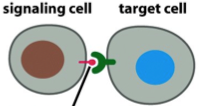
|
contact-dependent signaling |
|
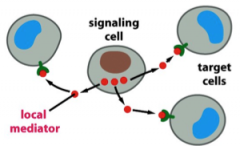
|
paracrine signaling |
|
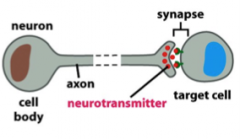
|
synaptic signaling |
|

|
endocrine siganling |
|
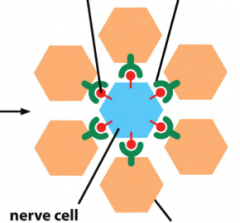
|
contact-dependent signaling |
|

|
gap junction |
|
|
gap junction |
1. allow exchange of inorganic ions & small water soluable molecules 2. does not allow for exchange of proteins or nucleic acids 3. communication can occur in both directions 4. typical signals transmitted: Ca++ or cAMP |
|

|
connexins |
|
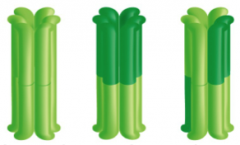
|
connexons |
|

signaling factor gradients |
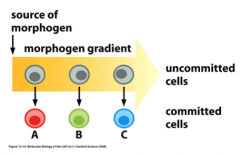
intercellular channels |
|
|
intracellular receptors |
specify cell fate |
|
|
NO intracellular signaling |
* |
|
|
NO intracellular signaling pathway |
1. activated nerve terminal 2. release Ach 3. Ach binds to and activates NOS on EC 4. arginine signaling generates NO 5. rapid diffusion of NO across membranes 6. NO bound to guanylyl cyclase 7. signals GTP --> cGMP 8. rapid relaxation of smooth muscle cell |
|
|
NOS |
NO synthase |
|
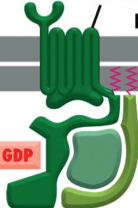
|
inactive G protein |
|
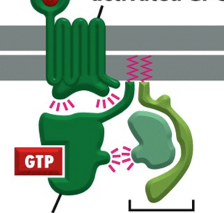
synthesis and degradation of cAMP |
activated G protein |
|
|
LEFT |
ATP -- adenylyl cyclase --> cAMP --> cAMP phosphodiesterase --> 5' -AMP |
|
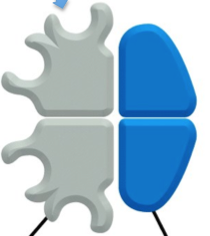
RIGHT |
1. inactive form 2. regulatory subunit 3. cAMP binding sites |
|
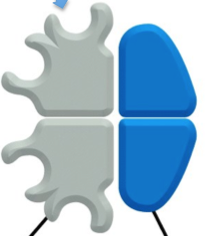
what happens when changes in cAMP concentration occurs? |
1. inactive catalytic subunit 2. becomes active when cAMP binds to regulatory subunits |
|
|
GPCRF intracellular Ca regulation pathway |
alteration of gene transcription |
|
|
GPCR intracellular Ca regulatory pathway |
1. signal molecule binds/activated GPCR 2. activated Gq protein 3. activated phospholipase C-Beta 4. PI 4,5-biphosphate [PI(4,5)P2]dissociates into diacylglycerol AND inositol 1,4,5-trisphosphate (IP3) 5a. IP3 bidns to lumen of ER 5b. diacylglycerol binds to inactive protein kinase C 6a. Ca++ opens IP3-gated Ca++ release channels 7a. Ca++ released from ER lumen 8a. Ca++ binds/activates protein kinase C
|

